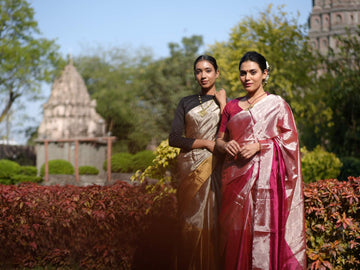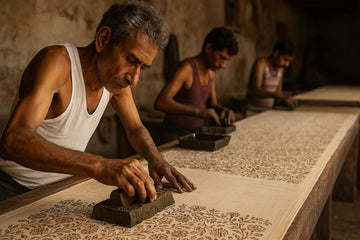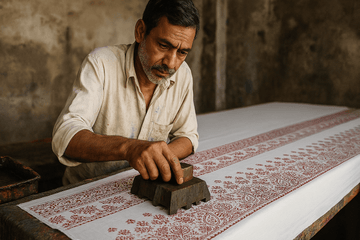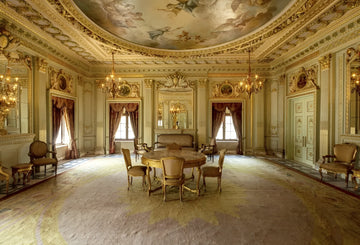4 Types of Chanderi Handloom Sarees - A Legacy of Sheer Elegance and Timeless Weaving
by Rahul Patwa on Feb 01, 2025

India’s rich handloom traditions have gifted the world some of the finest weaves, and among them, Chanderi sarees hold a special place. Renowned for their lightweight texture, sheer fabric, and intricate zari work, these sarees have adorned royalty and connoisseurs of fine textiles for centuries. Woven in the historic town of Chanderi, Madhya Pradesh, these sarees embody the delicate balance of tradition and modernity.
In this blog, we will explore the origins, evolution, and different types of Chanderi sarees based on their fabric composition.
A Royal Legacy: The Origin of Chanderi Sarees
Chanderi sarees trace their origins back to the Vedic period, with records of the fabric being favored by royalty. The craft flourished under the patronage of the Bundela Rajputs and Mughal emperors, who admired the saree’s translucent texture and exquisite motifs. Traditionally, the yarn was handwoven using fine cotton and silk, often enriched with delicate zari borders and butis (small motifs).
Over time, Chanderi sarees have evolved into a symbol of grace, heritage, and luxury, gaining admiration from fashion designers and saree enthusiasts worldwide.
The Weaving Process: A Masterpiece of Craftsmanship
Chanderi sarees are meticulously woven on traditional handlooms, using a unique weaving technique that imparts the fabric with its characteristic sheen and lightweight texture. The fabric is woven with extra weft motifs, often depicting floral, geometric, and peacock designs, inspired by nature and Mughal architecture. The weaving process is labor-intensive, requiring precision, skill, and an artistic eye to maintain the finesse of the weave.
Types of Chanderi Handloom Sarees Based on Fabric
Chanderi sarees are classified based on the type of yarn used in weaving. The fabric determines the saree’s texture, drape, and overall aesthetic appeal.
1. Pure Cotton Chanderi Handloom Sarees
-
Warp: Cotton, Weft: Cotton
-
Made entirely from high-quality hand-spun cotton yarn, these sarees are known for their soft and breathable texture.
-
Ideal for summer wear, formal occasions, and office attire.
-
Features delicate zari work, floral motifs, and fine checkered patterns.
-
The pastel shades and subtle golden border make them a timeless classic.
2. Silk-Cotton Chanderi Handloom Sarees
-
Warp: Silk, Weft: Cotton
-
A blend of silk and cotton, these sarees combine the comfort of cotton with the luxurious sheen of silk.
-
Lightweight yet elegant, making them perfect for semi-formal and festive occasions.
-
The fabric has a slightly crisp texture, enhancing the drape of the saree.
-
Often adorned with traditional butis, paisley motifs, and intricate golden zari pallus.
- They also include Chanderi Handloom Katan Silk Sarees ideal for weddings.
3. Pure Silk Chanderi Handloom Sarees aka Chanderi Pattu Silk Sarees
-
Warp: Silk, Weft: Silk
-
Woven entirely from fine silk threads, these sarees exude grandeur and sophistication.
-
Commonly worn at weddings, festive occasions, and special events.
-
The fabric is soft, lustrous, and adorned with intricate zari work that enhances its opulence.
-
Designs often feature royal motifs such as peacocks, lotuses, and temple borders.
4. Tissue Chanderi Handloom Sarees
-
Warp: Silk, Weft: Zari
-
Crafted with silk and zari threads, giving the saree a shimmering, ethereal look.
-
Known for their glossy, transparent texture, perfect for evening wear and grand celebrations.
-
These sarees are lightweight yet luxurious, often featuring delicate embroidery and zari-infused motifs.
-
Popular in contemporary fashion due to their blend of tradition and glamour.
Chanderi vs. Other Silk Weaves: Katan and Pattu Silk
While Chanderi sarees are renowned for their lightweight and sheer texture, other silk sarees like Katan silk and Pattu silk have distinct characteristics:
Katan Silk vs. Chanderi Silk
-
Katan Silk: A heavier silk fabric made by twisting multiple silk filaments, giving it a more structured and durable texture.
-
Chanderi Silk: Uses finer silk threads woven into a lightweight, sheer fabric with a soft drape.
-
Usage: Katan silk is primarily associated with Banarasi sarees, while Chanderi silk is unique to Madhya Pradesh.
Pattu Silk vs. Chanderi Silk
-
Pattu Silk: A rich, thick silk fabric mostly woven in South India, particularly Tamil Nadu and Andhra Pradesh.
-
Chanderi Silk: Lighter and airier, often featuring intricate Mughal-inspired motifs and fine zari work.
-
Usage: Pattu silk is heavily used in South Indian bridal wear, whereas Chanderi silk is favored for its elegant translucency and understated luxury.
Understanding these distinctions helps in appreciating the uniqueness of Chanderi silk sarees, making them a preferred choice for those who value elegance and comfort.
Signature Motifs and Patterns in Chanderi Sarees
The beauty of Chanderi sarees lies in their intricate motifs, often inspired by nature and royal architecture. Some of the most distinctive patterns include:
-
Ashrafi Buti (Coin Motif): Small circular motifs symbolizing prosperity.
-
Phool-Patta (Floral Motifs): Intricate flowers and leaves, adding a touch of elegance.
-
Meenakari (Enamel Work): Multicolored threadwork reminiscent of jewelry designs.
-
Keri (Paisley Motif): A timeless mango-shaped pattern symbolizing growth and fertility.
-
Jangla (Jungle Design): A complex intertwining of floral and foliage patterns.
The Undying Charm of Chanderi Sarees
Chanderi sarees continue to be cherished by saree lovers across generations. Their lightweight drape, fine texture, and timeless appeal make them a must-have in every handloom enthusiast’s wardrobe. Whether worn casually or at grand celebrations, a Chanderi saree is a statement of elegance, heritage, and sustainable fashion.
As handloom weaving faces challenges from mass-produced textiles, supporting Chanderi sarees means investing in the livelihoods of artisans and preserving an age-old tradition. The next time you choose a saree, let it be a Chanderi weave – a masterpiece of Indian craftsmanship and regal splendor.




